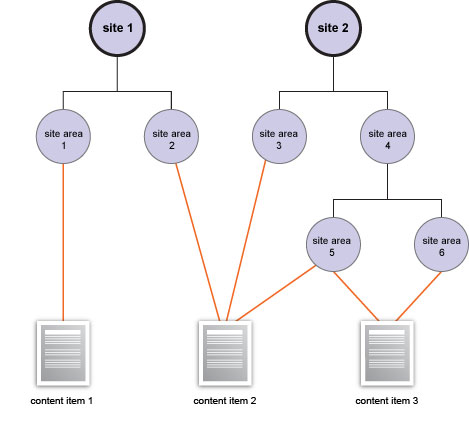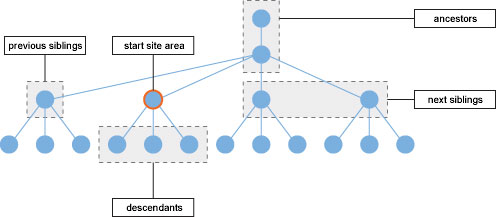Portal Express, Version 6.0
Operating systems: i5/OS, Linux, Windows
Plan a site framework
Before creating a site framework, you should analyze your proposed site and determine the best way to develop your site framework.
The items that make up a site framework
A site framework consists of a single top-level site containing a set of site areas that contain content items. Although a site framework contains only a single site item, you can create multiple site frameworks for use in a single Web site.

- Sites:
-
- A site is the top-level item in a site framework. Each site framework must contain a site, but a site framework can only contain a single site item.
- You save site areas within sites.
- You define the default mappings between authoring templates and presentation templates for an entire site in site items. Mappings set in site areas overrule mappings that are set in sites.
- Site specific Web content is stored in sites in the form of elements.
- Site Areas:
-
- You use site areas to build the site framework within which you group content items. The site areas that comprise the site framework can be classified into ancestors, descendants and siblings. The vertical hierarchy of a site is split into ancestors and descendants. Depending on where you are within your site, site areas can act as ancestors and descendants. Site Areas that share the same ancestor are known as siblings.

- The relationships between authoring templates and presentation templates are set in site areas.
- Site area specific Web content is stored in site areas in the form of elements.
- You use site areas to build the site framework within which you group content items. The site areas that comprise the site framework can be classified into ancestors, descendants and siblings. The vertical hierarchy of a site is split into ancestors and descendants. Depending on where you are within your site, site areas can act as ancestors and descendants. Site Areas that share the same ancestor are known as siblings.
- Content items:
-
- You use content items to store Web page specific content in the form of elements.
- You save content items within site areas.
- You can save content items within multiple site areas and multiple site frameworks.
- You must select an authoring template when creating content items. The authoring template determines which elements are available to enter Web content into.
- The site area a content item is located under, and the content item's authoring template, determines which presentation template to use to display elements stored within a content item.
- You use categories and keywords to profile content items that the IBM® Workplace Web Content Management™ application uses to generate further pieces of content such as menus.
When to use sites, site areas and content items
Sites and site areas and content items are similar item-types. They all store Web content in the form of elements, but they are used in different ways:- A site is always used as the top-level item in a site framework.
- Site areas are used to define different sections within a site framework.
- Content items represent Web page specific content and can be used in multiple site areas and multiple site frameworks.
The structure of a Web site will determine whether a single site framework, or multiple site frameworks are used.
In the following examples, a company sells three different product brands.
Example 1: A single web site
In this example, the simplest method to use is a Web site comprising a single site framework with multiple site areas:
|
Example 2: Intranet, extranet and Web site
In this example, a separate site framework is created for an intranet, an extranet and a Web site. Some content items are used in more than one site framework.
| Intranet | Extranet | Web site |
|---|---|---|
|
|
|